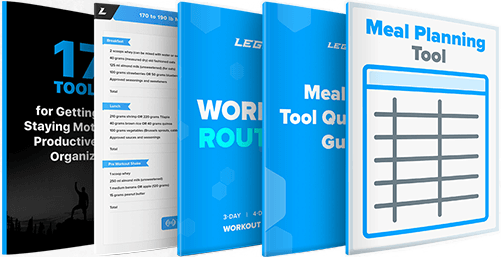Use a Deload Week to Gain Muscle & Strength
You’ve probably heard that if you want to build the body of your dreams you need to front the gym, day in, day out, and give it your all.
And that’s true . . . to an extent.
You see, if you punish your body with intense workouts for months on end without taking breaks your journey will be marred by . . .
- Regular plateaus
- Overuse injuries
- Lack of motivation
- Lackluster workouts
And that isn’t an effective, efficient, or enjoyable way to go about things.
But that’s where deload weeks come in.
A deload week is a planned period of rest and recovery that’s designed to help you avoid the pitfalls of constant intense exercise.
Implement them correctly, and they’re one of the most effective ways to prevent injuries, plateaus, and burnout.
Execute them badly, however, and they’ll either fail to adequately boost recovery, or simply waste time that could be spent doing just about anything else.
In this article you’ll learn everything you need to know about how to make deload weeks work for you, including what a deload is, why people deload, how often you should deload, how to deload properly, and the best deload workouts you can do.
What Is a Deload Week?
A deload week is a weeklong reduction in training volume or intensity (usually measured in terms of sets and weight lifted, respectively) to give your body and mind a break from the rigors of hard training.
For example, if your normal weightlifting routine consists of 80 hard sets per week, a deload week might cut the volume in half (40 sets, for instance) or dramatically reduce the intensity (lifting 50% of your normal hard set weight is common).
Typically, deload weeks are scheduled after a period of intense training, though the length of time between deload weeks depends on the program you follow. For example, in my Bigger Leaner Stronger and Thinner Leaner Stronger programs, deload weeks are recommended every 8-to-10 weeks of hard training.
However, in my Beyond Bigger Leaner Stronger program, the volume, intensity, and progression scheme is such that it’s better to take a deload week every fourth week of training.
Why Do People Deload?
Regular resistance training puts stress and strain on your body that you need to recover from.
However, not all parts of the body recover at the same rate. Your central nervous system, for example, recovers from a heavy workout within a matter of minutes, whereas your muscles typically require a few days of R&R before they’re in shipshape.
Some tissues in the body take much longer to heal, though, like tendons, ligaments, and bones.
If you’re lifting heavy weights regularly, these tissues suffer small microtrauma and tears, and if not allowed to heal, this damage can eventually lead to strains or injuries.
Taking regular deload weeks gives your body a chance to clean up the various types of residual stress that accumulate over weeks of hard training. Think of it as an insurance policy of sorts against injury and overreaching.
Deload weeks also allow you to have more productive workouts.
If you train hard for weeks or months without a break, you eventually reach a point where progress stalls because you’re only recovering enough to repeat the same workouts over and over (a plateau).
Taking a deload week gives you the time away from hard training that you need to recoup your verve and strength, lift heavier weights, and thus build more muscle over time.
In other words, you’ll do much better with a month or two of hard training followed by a deload and another month or two of hard training than two-to-four months of continuous max-effort work.
How Often You Should Deload
There’s no “one-size-fits-all” answer to how often you should plan a deload week because it largely depends on how experienced you are (more advanced people will need to deload more often because they tend to lift heavier weights than newbies), and how much abuse your body can take.
That said, here are some effective rules of thumb:
- If you’re new to training, plan a deload week after every 8-to-10 weeks of heavy, intense weightlifting. If you’re in a calorie deficit, reduce this to every 6-to-8 weeks (and yes, you should continue training heavy when in a calorie deficit).
- If you’ve been lifting weights for 1-to-3 years, plan a deload week after every 6-to-8 weeks of heavy, intense weightlifting. Reduce this to every 4-to-6 weeks if you’re in a calorie deficit.
- If you’ve been lifting weights for 3-to-6 years or more, plan a deload week after every 3-to-6 weeks of heavy, intense weightlifting. Use the same deload frequency if you’re in a calorie deficit.
If you’re new to deloading, I recommend you plan a deload week in advance and stick to it regardless of how you feel. This ensures you don’t accidentally increase your risk of injury or overreaching by stubbornly refusing to let off the gas (been there, done that).
However, as you learn more about how your body responds to training, you can get a bit looser with your deload timing. You’ll begin to recognize the need for a deload week—progress has stalled, body is achy, decreased motivation to train, workouts feel much harder than they should, etc.—and can respond accordingly.
And if you never feel the need to deload, your workout routine is probably too easy. That is, if you only ever show up to the gym and go through the motions, and never push yourself to lift heavy and progressively overload your muscles, then you’ll probably never tax your body enough to warrant taking a deload.
(If that’s the case for you, it’s probably time that you started a more effective training program.)
How to Deload Properly
There are numerous ways to deload effectively. Which method you use depends on your circumstances.
Let’s take a look at three of the best deload week strategies, and how you can use them in your training.
Volume Deload
A volume deload involves reducing the amount of volume you do, but maintaining the intensity you normally use in your workouts.
To successfully volume deload, follow these steps in your deload workouts for all the exercises you do:
- Use the same weights you lifted in your previous hard training session.
- Reduce the number of sets you do in your workouts by 30-to-50%.
- Do 2-to-4 fewer reps in each set than you did in your previous hard training session.
So, for instance, if I deadlifted 405 pounds for 3 sets of 6 reps in my last session of hard training, during a volume deload workout I would do 2 sets of 3 reps at 405 pounds (a 33% reduction in volume and 3 fewer reps per set).
Deloading like this is beneficial because . . .
- It lowers your weekly volume and ensures you don’t train to failure, which allows your body to recover.
- It enables you to train with heavy weights, which helps you maintain technical proficiency, and means you don’t have to feel your way back into heavy weightlifting in your first week back of normal training.
For the record, volume deload weeks are my preferred method of deloading (and exactly what I recommend in my programs for men and women, Bigger Leaner Stronger and Thinner Leaner Stronger)
Full Deload
A full deload involves lowering training volume and intensity. Here’s what you need to do in your full deload workouts for all the exercises in your program:
- Use 50% of the weight you lifted in your previous hard training session.
- Reduce the number of sets you do in your workouts by 30-to-50%.
- Do 50% fewer reps in each set than you did in your previous hard training session.
So, if I deadlifted 405 pounds for 3 sets of 6 reps in my last session of hard training, during a full deload workout I would do 2 sets of 3 reps at ~200 pounds.
A full deload like this is useful if you’re feeling particularly beaten up from training, if you’re susceptible to overuse injuries, or if you’re in your 40s, 50s, 60s, or beyond, and want to give your body as much time as possible to recover.
Selective Deload
Selective deloading is a method of deloading designed to help you break through a weightlifting plateau.
It involves reducing volume and intensity on a single exercise (normally a compound exercise such as the squat, deadlift, or bench or overhead press) that you’re no longer progressing on while keeping all other aspects of your training the same.
For example, let’s say that despite trying your hardest, you’ve deadlifted the same weight for the same number of reps in your last four back workouts, but you’re progressing as normal on all your other exercises.
Since you haven’t been able to increase the weight or reps for three or more consecutive workouts, you can consider your deadlift progress plateaued.
In this case, you’d take a selective deload for the deadlift only and follow these steps next time you deadlift:
- Use 50% of the weight you deadlifted in your previous hard training session.
- Reduce the number of sets (volume) of deadlifts you do in your workout by 30-to-50%.
- Do 50% fewer reps in each set of deadlifts than you did in your previous hard training session.
After your selective deload workout, go back to training as you were before, and assuming you’ve got the other aspects of your training, nutrition, and recovery in order, you should find your deadlift numbers start to move in the right direction again.
It’s normally best to use a selective deload any time you find your progress on a compound exercise has stalled and you’re still several weeks away from either a volume deload or a full deload.
You can also use selective deloads with isolation exercises, but often, you’re better off just swapping out the stalled isolation exercise with a similar one.
For example, if you haven’t added weight to cable triceps extensions for three weeks in a row, you could do a selective deload, or simply switch to dumbbell triceps presses instead (my preferred method).
FAQ #1: Will I lose my gains during a deload?
No.
Assuming you’re not in a calorie deficit, most studies show that muscle and strength loss doesn’t begin until after two or three weeks of no weightlifting or formal exercise of any kind (or even longer if you’ve been training for several years).
Also, remember that during a proper deload you’re still lifting heavy weights—just not as much or as intensely as you usually do. While these workouts may feel like a waste of time, they go a long way in helping you maintain muscle mass.
So, my point is this: If you follow the advice in this article, there’s more or less a zero percent chance you’ll lose muscle or strength during a deload.
FAQ #2: Can I take a week off instead?
Yes, but deloading is preferable because it’ll produce better results.
That said, if you’re traveling, sick (or on the brink), or ragged, take the week off instead. It’s also helpful to plan your deloads or rest weeks to coincide with trips, holidays, vacations, or any other forthcoming disruptions to your routine. This way, you don’t have to interrupt your hard training.
FAQ #3: Can I do cardio on my deload week?
Sure.
That said, remember the goal is to significantly reduce the amount of stress on your body. So walking or light physical activity is okay, but skip the high-intensity and high-impact cardio (sprinting, for example).
FAQ #4: How should I eat during a deload?
If you’re maintaining, continue to eat as normal.
If you’re cutting, you can maintain your current calorie intake while deloading, unless you feel the need for a diet break, in which case you can increase your calorie intake to your approximate total daily energy expenditure (TDEE).
If you’re lean bulking, you can maintain your current calorie intake or reduce it to your approximate TDEE if you’d like a break from all the food.
You should also continue to take any supplements that are cumulative in nature, such as creatine and beta-alanine, because this will keep their levels in your muscles topped off and ready to be used once normal training resumes.
Other supplements such as protein are optional, though taking a protein supplement during a deload week is a convenient way to make sure you hit your protein target every day.
(And if you’d like to know more about exactly what supplements could help you reach your fitness goals, take the Legion Supplement Finder Quiz.)
+ Scientific References
- DT, M., N, G., J, C., & M, M. (2013). The development, retention and decay rates of strength and power in elite rugby union, rugby league and American football: a systematic review. Sports Medicine (Auckland, N.Z.), 43(5), 367–384. https://doi.org/10.1007/S40279-013-0031-3
- Ogasawara, R., Yasuda, T., Ishii, N., & Abe, T. (2013). Comparison of muscle hypertrophy following 6-month of continuous and periodic strength training. European Journal of Applied Physiology, 113(4), 975–985. https://doi.org/10.1007/S00421-012-2511-9
- K, H., M, A., M, K., RU, N., & WJ, K. (2000). Neuromuscular adaptation during prolonged strength training, detraining and re-strength-training in middle-aged and elderly people. European Journal of Applied Physiology, 83(1), 51–62. https://doi.org/10.1007/S004210000248
- JG, J., A, N., LL, A., P, S., & JL, A. (2011). Myostatin expression during human muscle hypertrophy and subsequent atrophy: increased myostatin with detraining. Scandinavian Journal of Medicine & Science in Sports, 21(2), 215–223. https://doi.org/10.1111/J.1600-0838.2009.01044.X
- GE, M., CI, M., A, B., K, W., & GL, O. (2014). Impact of range of motion during ecologically valid resistance training protocols on muscle size, subcutaneous fat, and strength. Journal of Strength and Conditioning Research, 28(1), 245–255. https://doi.org/10.1519/JSC.0B013E318297143A
- HJ, P., DA, T., MJ, B., JW, K., & MR, M. (2016). Tapering Practices of New Zealand’s Elite Raw Powerlifters. Journal of Strength and Conditioning Research, 30(7), 1796–1804. https://doi.org/10.1519/JSC.0000000000001292
- MC, Z., A, K., C, D., JM, Q., KA, S., E, J., E, H., B, E., S, D., S, G. M., & R, B. (2016). Novel Resistance Training-Specific Rating of Perceived Exertion Scale Measuring Repetitions in Reserve. Journal of Strength and Conditioning Research, 30(1), 267–275. https://doi.org/10.1519/JSC.0000000000001049
- Cook, J. L., Rio, E., Purdam, C. R., & Docking, S. I. (2016). Revisiting the continuum model of tendon pathology: what is its merit in clinical practice and research? British Journal of Sports Medicine, 50(19), 1187. https://doi.org/10.1136/BJSPORTS-2015-095422
- KM, K., JL, C., JE, T., & F, B. (2000). Overuse tendinosis, not tendinitis part 1: a new paradigm for a difficult clinical problem. The Physician and Sportsmedicine, 28(5), 38–48. https://doi.org/10.3810/PSM.2000.05.890
- KM, K., JL, C., F, B., P, H., & M, A. (1999). Histopathology of common tendinopathies. Update and implications for clinical management. Sports Medicine (Auckland, N.Z.), 27(6), 393–408. https://doi.org/10.2165/00007256-199927060-00004
- Latella, C., Hendy, A. M., Pearce, A. J., VanderWesthuizen, D., & Teo, W.-P. (2016). The Time-Course of Acute Changes in Corticospinal Excitability, Intra-Cortical Inhibition and Facilitation Following a Single-Session Heavy Strength Training of the Biceps Brachii. Frontiers in Human Neuroscience, 10(DEC2016). https://doi.org/10.3389/FNHUM.2016.00607
If you enjoyed this article, get weekly updates. It’s free.
Sending…
Great! You’re subscribed.
100% Privacy. We don’t rent or share our email lists.









